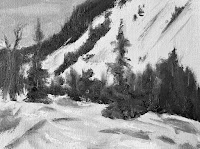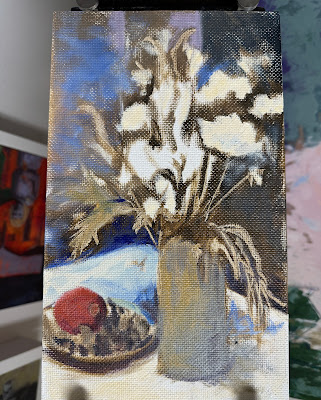My Valentine's Day painting and snowshoeing adventure
happened because the day dawned sunny,
not too cold, and windless. I have said that I am a fair-weather painter
and even though it was not 70° out, I did consider it "fair weather" because of
all the sun and no wind!!
The other thing I wanted to do besides paint outside on this lovely day was
to try out my electric socks that Santa brought me for xmas. Ever since our dog mushing days in Fairbanks, my feet have been very sensitive to the cold.
all the snow we have had, I thought it might be a good place to find a winter scene to paint.
Near the lodge in the upper parking area, there was a x-country ski trail (?) that had not been used for several snowfalls, so I trekked uphill on that trail to find a spot to set up.
Once I found a good place, I trekked back to the car, got my pack
and headed up.
 |
| ready to paint standing in my snowshoes |
I realized that my skinny tripod legs might sink down too deep in the snow!
But I tested it and it held while I snapped my pochade box onto the tripod.
The first thing I saw as I surveyed the scene was a Ptarmigan!
So white! even against the snow ... and moving very slowly because it saw me.
 |
Willow Ptarmigan (Lagopus lagopus)
Alaska State Bird |
The shadows and the sparkly snow were really enticing. I think the temperature was about 30° and the sun was at my back. I could block the sun with my body so my colors weren't washed out on my painting and palette. I'd forgotten to bring my umbrella.
My set up was pretty near the bunny hill
and it must have been a school learn-to-ski day,
because there were recess-like playground shouts
and happy voices echoing through the air.
Another voice I heard echoing in the valley was
the cry of a Red-tailed Hawk (Buteo jamaicensis alascensis).
 |
| first painting - 5 x 7 |
My painting went well ... so well that I was finished with this small one in about an hour.
Since I had another panel, & I was still not too cold,
I decided to try another painting.
I had to work fast because I didn't want to
have the sun go down while I was there, or get cold. In a situation like this,
painting as quickly as I could and concentrating
on just the big shapes with no detail
helps me to not make the painting too tight.
Have you heard the saying "think slow & paint fast"?
I feel like I did accomplish that;
For me, I got a nice representation of the feeling of being up there
in the snow with the Ptarmigan and hawk.
 |
| 2nd painting - 8 x 10 |
The electric socks helped me to stay standing on the snow for nearly two hours. But I learned I should move around a bit more, even with the socks on (they are so neat, there's an app on my phone to turn the heat up or down!).
So here are the two paintings. I took pictures of them outside today (another nice day!).
 |
Ptarmigan Country
oil on linen mounted on Mulitmedia artboard |
 |
Eaglecrest Valentine
oil on Masonite
|
Thank you for reading about my 🩷Valentine's Day adventure!
Please let me know if you have any questions.
Happy painting and creating!
♥♡♥
🎨



































.jpeg)










